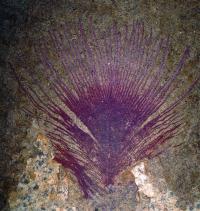Home > Press > Scientists find evidence of iridescence in 40 million-year-old feather fossil
 |
| Scientists discovered that nanostructures found in this 40-million-year-old fossil were responsible for producing iridescent colors in the living feather. |
Abstract:
Known for their wide variety of vibrant plumage, birds have evolved various chemical and physical mechanisms to produce these beautiful colors over millions of years. A team of paleontologists and ornithologists led by Yale University has now discovered evidence of vivid iridescent colors in feather fossils more than 40 million years old.
Scientists find evidence of iridescence in 40 million-year-old feather fossil
New Haven, CT | Posted on August 27th, 2009The finding, published online August 26 in Biology Letters, signifies the first evidence of a preserved color-producing nanostructure in a fossilized feather.
Iridescence is the quality of changing color depending on the angle of observation, such as the rainbow of colors seen in an oil slick. The simplest iridescent feather colors are produced by light scattering off the feather's surface and a smooth surface of melanin pigment granules within the feather protein. Examining feather fossils from the Messel Shale in Germany with an electron microscope, scientists have documented this smooth layer of melanin structures, called melanosomes.
"These feathers produced a black background with a metallic greenish, bluish or coppery color at certain angles—much like the colors we see in starlings and grackles today," said Richard Prum, chair of the Department of Ecology & Evolutionary Biology at Yale and one of the paper's authors.
For more than 25 years, paleontologists have found microscopic tubular structures on fossilized feathers and hair. These were long interpreted as bacteria that had digested the feathers at the time they were fossilized. The team had previously discovered that these structures were in fact not bacteria but melanosomes, which then allowed them to document the original color patterns. Following up on the new finding, they are racing to discover what additional coloration features may be found in fossil feathers.
"The discovery of ultra-structural detail in feather fossils opens up remarkable possibilities for the investigation of other features in soft-bodied fossils, like fur and even internal organs," said Derek Briggs, Yale's Frederick William Beinecke Professor of Geology and Geophysics, and an author of the study.
The discovery could pave the way for determining color features of other ancient birds and even dinosaurs, the team said.
"Of course, the 'Holy Grail' in this program is reconstructing the colors of the feathered dinosaurs," said Yale graduate student and lead author Jakob Vinther. "We are working hard to determine if this will be possible."
Other authors of the paper include Julia Clarke (University of Texas at Austin) and Gerald Mayr (Senckenberg Research Institute, Germany).
Funding was provided by the National Science Foundation, the National Geographic Society and Yale University.
Citation: Biology Letters (doi:10.1098/rsbl.2009.0524)
####
About Yale University
Yale University comprises three major academic components: Yale College (the undergraduate program), the Graduate School of Arts and Sciences, and the professional schools. In addition, Yale encompasses a wide array of centers and programs, libraries, museums, and administrative support offices. Approximately 11,250 students attend Yale.
For more information, please click here
Contacts:
Suzanne Taylor Muzzin
203-432-8555
Copyright © EurekAlert
If you have a comment, please Contact us.Issuers of news releases, not 7th Wave, Inc. or Nanotechnology Now, are solely responsible for the accuracy of the content.
| Related News Press |
News and information
![]() Simulating magnetization in a Heisenberg quantum spin chain April 5th, 2024
Simulating magnetization in a Heisenberg quantum spin chain April 5th, 2024
![]() NRL charters Navy’s quantum inertial navigation path to reduce drift April 5th, 2024
NRL charters Navy’s quantum inertial navigation path to reduce drift April 5th, 2024
![]() Discovery points path to flash-like memory for storing qubits: Rice find could hasten development of nonvolatile quantum memory April 5th, 2024
Discovery points path to flash-like memory for storing qubits: Rice find could hasten development of nonvolatile quantum memory April 5th, 2024
Possible Futures
![]() Discovery points path to flash-like memory for storing qubits: Rice find could hasten development of nonvolatile quantum memory April 5th, 2024
Discovery points path to flash-like memory for storing qubits: Rice find could hasten development of nonvolatile quantum memory April 5th, 2024
![]() With VECSELs towards the quantum internet Fraunhofer: IAF achieves record output power with VECSEL for quantum frequency converters April 5th, 2024
With VECSELs towards the quantum internet Fraunhofer: IAF achieves record output power with VECSEL for quantum frequency converters April 5th, 2024
Discoveries
![]() Chemical reactions can scramble quantum information as well as black holes April 5th, 2024
Chemical reactions can scramble quantum information as well as black holes April 5th, 2024
![]() New micromaterial releases nanoparticles that selectively destroy cancer cells April 5th, 2024
New micromaterial releases nanoparticles that selectively destroy cancer cells April 5th, 2024
![]() Utilizing palladium for addressing contact issues of buried oxide thin film transistors April 5th, 2024
Utilizing palladium for addressing contact issues of buried oxide thin film transistors April 5th, 2024
Announcements
![]() NRL charters Navy’s quantum inertial navigation path to reduce drift April 5th, 2024
NRL charters Navy’s quantum inertial navigation path to reduce drift April 5th, 2024
![]() Discovery points path to flash-like memory for storing qubits: Rice find could hasten development of nonvolatile quantum memory April 5th, 2024
Discovery points path to flash-like memory for storing qubits: Rice find could hasten development of nonvolatile quantum memory April 5th, 2024
|
|
||
|
|
||
| The latest news from around the world, FREE | ||
|
|
||
|
|
||
| Premium Products | ||
|
|
||
|
Only the news you want to read!
Learn More |
||
|
|
||
|
Full-service, expert consulting
Learn More |
||
|
|
||








